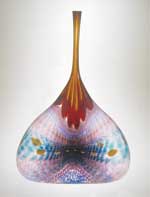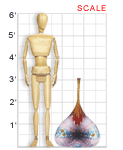VAM galleries including this work:
Kentucky Artisan Center at Berea | Do You See a Pattern? || VAM Home
Stephen Rolfe Powell (Kentucky, b. 1951)
CATATONIC HALLUCINATION JONES, 2002
Blown glass with murrini; 38" X 26" X 6.5"
On loan to the Kentucky Artisan Center
Catatonic Hallucination Jones is one of three works by Stephen Powell at the Kentucky Artisan Center at Berea. All three pieces incorporate the murrini design technique that Powell is known for and were created by a team of studio assistants who worked with him.
These large works require careful design steps and great glassblowing skill. The hot glass process begins with a design for the color patterns that will be on the surface of each vessel. Powell creates the patterns by melting colored glass, overlaying it with another color, and then stretching it while molten across the studio floor into a long rod. These rods are sliced into small discs called murrini and organized according to their colors. The murrini are then arranged in rows on a light table, which is where the pattern of each piece is determined. Powell uses roughly 2,500 or more murrini for a single work.
Once the layout of colored sliced glass is complete, it is transferred to a hot plate in the studio. Powell then “gathers” liquid glass from the glass furnace onto a blowpipe, or metal tube, used to gather a blob of molten glass. The molten glass is shaped into a compressed, symmetrical shape on a marver, an iron or steel table with a perfectly flat surface. This process is repeated until there is a large enough amount of glass on the pipe.
Then Powell goes back to the hot plate with the colored glass discs. He rolls the hot clear glass on his blowpipe over the hot plate to pick up the colored murrini disks, which adhere to the surface of the clear glass. He then compresses the glass on the marver and reheats it. Then Powell steps onto a tall platform, swings the blowpipe downward into a metal form, and blows the shape and pulls the neck upward while his assistants use a blowtorch to keep the entire glass piece hot enough to shape. The bottle form is then removed or cut from the blowpipe and placed in an annealing kiln, a chamber of brick or fibrofrax where special controlled cooling of the glass can take place.
About the Artist
Stephen Rolfe Powell was born in 1951 in Birmingham, Alabama. After receiving a Bachelor of Arts in painting and ceramics at Kentucky’s Centre College, he went on to earn a Master of Fine Arts in ceramics at Louisiana State University. It was at LSU, between 1980 and 1983, that Powell had his first experience in glassblowing. Glass has been a full-time obsession for him as a teacher and artist ever since.
Powell exhibits his work nationally and internationally. He has participated in workshops, demonstrations, and lectures all over the United States and in Russia, Ukraine, Australia, and New Zealand. One highlight of his travels was an exhibition of his work at Venezia Aperto Vetro in the Palazzo Ducale in Venice, Italy, where he was one of only eight American artists invited to participate.
In 1983, Powell returned to Kentucky to teach at his alma mater, Centre College in Danville. Hired to teach ceramics and sculpture, he set about establishing a program to teach his first love—glassblowing. By 1985, thanks in part to Corning Glass in Harrodsburg, Philips Lighting in Danville, and Corhart in Louisville, he had built a glass studio and founded Centre’s glass program, which has attracted students from around the country. In 1997, again thanks to his previous corporate sponsors as well as General Electric in Somerset, Powell designed and completed a state-of-the-art glass studio, which Centre opened as part of the new Jones Visual Arts Center in January 1998. The new art facility has been host to such visiting artists as Marvin Lipofsky, Lino Tagliapietra, Richard Jolley, and Jose Chardiet.
Powell was honored with Kentucky Teacher of the Year awards in 1999 and 2000. In 2004, the Kentucky Council on Postsecondary Education presented him with the Acorn Award, and Powell and Centre College hosted master Italian glassblower Tagliapietra to grant him an honorary Doctor of Humane Letters degree. Powell also co-produced the film Lino Tagliapietra: Glass Maestro.
As an artist, Powell has been of seminal influence on the hot glass movement in Kentucky. Nearly all of the glass artists working in the state today have either been students of or apprenticed with Powell.
To see Powell at work, watch the “Glass: Stephen Rolfe Powell” video segment in Part 4 (3D Media/Processes) of the Spectrum of Art DVD in the Visual Arts Toolkit.
Classroom Ideas
Discussion: Compare this work to Powell’s other work in this gallery, Sobbing Fire Cleavage. What are the similarities and differences between the two pieces? Is it clear that they are both by the same artist? Why or why not?
Activities: Use sequins, confetti, or tissue paper cutouts and contact paper to try your own “murrini” artwork. Lay rows of the discs out on a flat surface in a patterned design. Then peel the protective backing off the contact paper and pick up the murrini with the adhesive side. Seal the back of the design with a second sheet of contact paper. Tape your work to a window so that the light shines through it.
Roll or press Silly Putty into a pancake, then use fine-tipped colored markers to draw tiny patterns of color in straight lines across it. Roll the pancake of putty with a rolling pin or pull and stretch it to see the patterns change and grow.
Links
More information about Stephen Rolfe Powell, including articles and reviews, a biography, a résumé, and photos of works, can be found on the artist’s web site.
[www.stephenrolfepowell.com]
See the art of master glassblower Lino Tagliapietra at his web site.
[www.linotagliapietra.com]
Learn more about glass at the Corning Museum of Glass and at Glass Online.
[www.cmog.org]
[www.glassonline.com/infoserv/history.html]


